中职英语模块1unit7全单元教案
- 格式:docx
- 大小:25.22 KB
- 文档页数:13

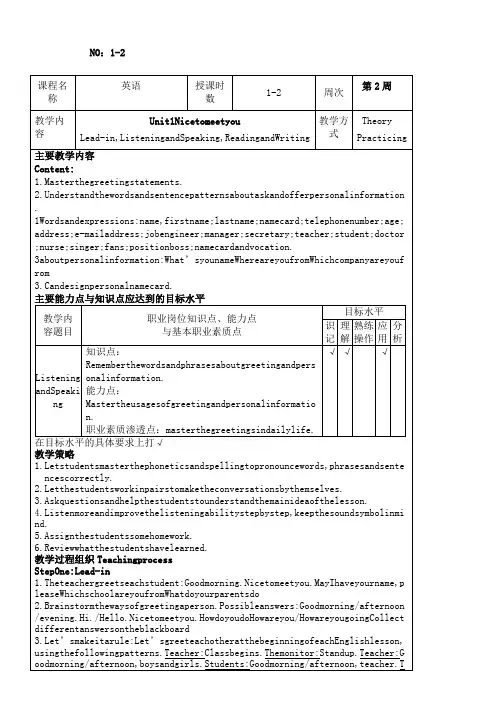
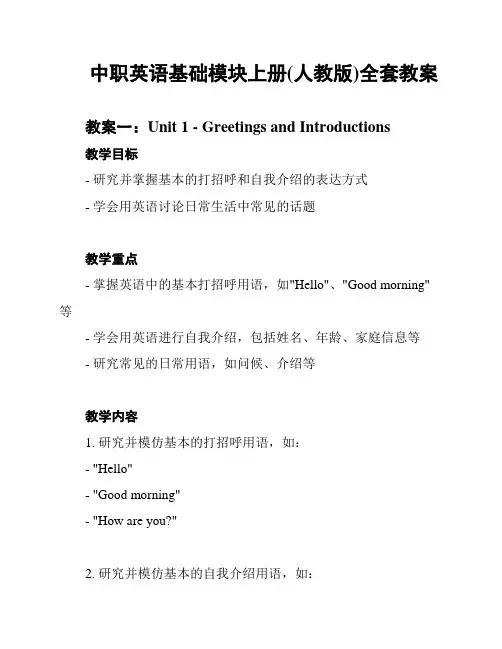
中职英语基础模块上册(人教版)全套教案教案一:Unit 1 - Greetings and Introductions教学目标- 研究并掌握基本的打招呼和自我介绍的表达方式- 学会用英语讨论日常生活中常见的话题教学重点- 掌握英语中的基本打招呼用语,如"Hello"、"Good morning"等- 学会用英语进行自我介绍,包括姓名、年龄、家庭信息等- 研究常见的日常用语,如问候、介绍等教学内容1. 研究并模仿基本的打招呼用语,如:- "Hello"- "Good morning"- "How are you?"2. 研究并模仿基本的自我介绍用语,如:- "My name is [name]."- "I am [age] years old."- "I live in [place]."3. 进行角色扮演,练打招呼和自我介绍的对话。
4. 研究并模仿常见的日常用语,如:- "Nice to meet you."- "Where are you from?"- "What do you like to do in your free time?"教学方法- 师生互动:通过师生问答、角色扮演等方式,进行实际口语练。
- 录音练:请学生录制并回放自己的自我介绍,进行口语语音纠正。
教学评估与反馈- 老师对学生进行口语表达的纠正和评估。
- 学生之间互相评价和反馈。
教案二:Unit 2 - Daily Routines教学目标- 研究并掌握日常生活中的常见动词和词组- 能够描述自己和他人的日常活动安排教学重点- 掌握英语中常见的动词和词组,如"get up"、"have breakfast"等- 学会用英语描述自己和他人的日常活动安排教学内容1. 研究并模仿常见的日常活动动词,如:- "get up"- "have breakfast"- "go to school"2. 研究并模仿描述日常活动的句子,如:- "I get up at 7 o'clock in the morning."- "She has breakfast with her family."3. 进行角色扮演,练描述日常活动安排的对话。
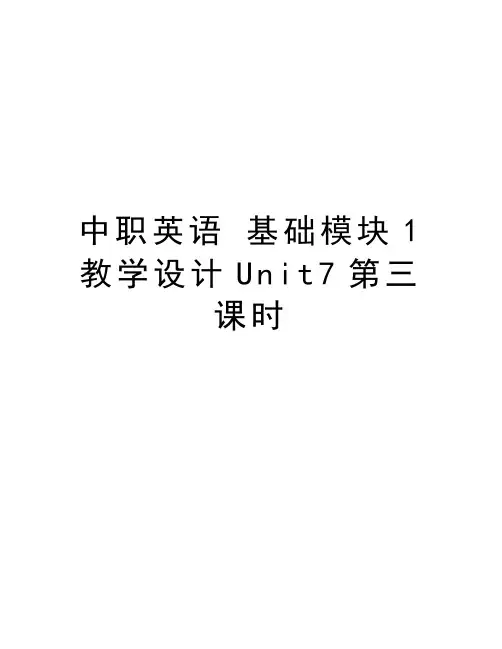
中职英语基础模块1教学设计U n i t7第三课时中职英语基础模块1 教学设计(教案、学案)Unit 7 第三课时Unit 7 Can I speak to Wang Yang?(第三课时教学设计)一、教材分析1、教学内容本课时系教材《英语1》(基础模块高教版)第七单元的第三课时reading and writing。
具体内容为:王洋发给美国网友Mike的邮件及围绕此邮件展开的相关练习。
本节课在整个单元中有非常重要的作用,它既是对上节听说课的复习和巩固,又为本单元的任务----描述一个最喜爱的运动员做好阅读和写作的准备。
因为e-mail与本班同学的专业计算机有一定的关系,故学生对此内容比较熟悉和感兴趣。
这为教师安排和设计教学过程打下了较好的基础,对于e-mail 邮件格式家伙司可以不必花太多的时间去讲解。
2、教学重点、难点(1)教学重点学习王洋写给Mike的e-mail 邮件内容(2)教学难点通过阅读和学习邮件学生能对文中内容作简要的描述。
二、教学目标1、知识目标学生能掌握下列词和词组: volunteer, sell goods, drive a car, put up posters, hand out booklets, provide sth. for sb., place flowers, be glad to do, more and more, look forward to2、能力目标通过阅读学生能理解e-mail的具体内容—担任奥运志愿者的工作,并通过具体活动完成课文相关的练习,从而提高阅读和写作能力3、情感目标鼓励学生通过e-mail的往来,加深彼此的了解和友谊三、教学步骤Step One Warm up 6’1. Teach new word “volunteer”Show a red cap of a volunteer.T: What’s this?S: …T: If you wear this cap, what are you?S:….T: Do you work as an volunteer?S:…T: What kind of work do you do as a volunteer?S: ….T: Here are some work, can you match?2. Match the phrases and the picturesShow some pictures on the screen. They are about: sell goods, drive a car, put up posters, hand out booklets, play volleyball, play the piano and write e-mailWhen students are doing it, teacher asks them to tell the Chinese meaning.设计意图:学校里有青年志愿者服务队,通过志愿者小红帽的展示来学习单词volunteer 学生会觉得印象比较深;通过图片对e-mail中的词组进行学习为课文学习做铺垫。

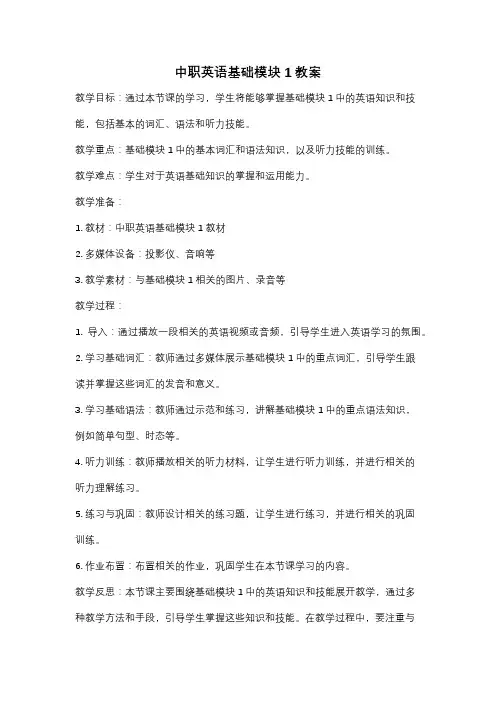
中职英语基础模块1教案
教学目标:通过本节课的学习,学生将能够掌握基础模块1中的英语知识和技能,包括基本的词汇、语法和听力技能。
教学重点:基础模块1中的基本词汇和语法知识,以及听力技能的训练。
教学难点:学生对于英语基础知识的掌握和运用能力。
教学准备:
1. 教材:中职英语基础模块1教材
2. 多媒体设备:投影仪、音响等
3. 教学素材:与基础模块1相关的图片、录音等
教学过程:
1. 导入:通过播放一段相关的英语视频或音频,引导学生进入英语学习的氛围。
2. 学习基础词汇:教师通过多媒体展示基础模块1中的重点词汇,引导学生跟
读并掌握这些词汇的发音和意义。
3. 学习基础语法:教师通过示范和练习,讲解基础模块1中的重点语法知识,
例如简单句型、时态等。
4. 听力训练:教师播放相关的听力材料,让学生进行听力训练,并进行相关的
听力理解练习。
5. 练习与巩固:教师设计相关的练习题,让学生进行练习,并进行相关的巩固
训练。
6. 作业布置:布置相关的作业,巩固学生在本节课学习的内容。
教学反思:本节课主要围绕基础模块1中的英语知识和技能展开教学,通过多
种教学方法和手段,引导学生掌握这些知识和技能。
在教学过程中,要注重与
学生的互动和引导,激发学生学习英语的兴趣,提高学生的学习积极性。
同时,要根据学生的实际情况,灵活调整教学方法和手段,确保教学效果的达成。
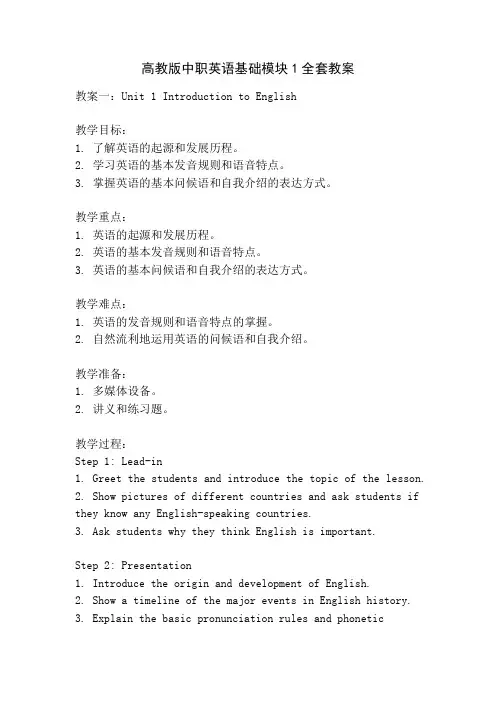
高教版中职英语基础模块1全套教案教案一:Unit 1 Introduction to English教学目标:1. 了解英语的起源和发展历程。
2. 学习英语的基本发音规则和语音特点。
3. 掌握英语的基本问候语和自我介绍的表达方式。
教学重点:1. 英语的起源和发展历程。
2. 英语的基本发音规则和语音特点。
3. 英语的基本问候语和自我介绍的表达方式。
教学难点:1. 英语的发音规则和语音特点的掌握。
2. 自然流利地运用英语的问候语和自我介绍。
教学准备:1. 多媒体设备。
2. 讲义和练习题。
教学过程:Step 1: Lead-in1. Greet the students and introduce the topic of the lesson.2. Show pictures of different countries and ask students if they know any English-speaking countries.3. Ask students why they think English is important.Step 2: Presentation1. Introduce the origin and development of English.2. Show a timeline of the major events in English history.3. Explain the basic pronunciation rules and phoneticfeatures of English.4. Use audio or video materials to demonstrate the correct pronunciation.Step 3: Practice1. Divide the class into pairs or small groups.2. Give students a list of common greetings and ask them to practice using them in different situations.3. Have students practice introducing themselves to each other using the phrases and sentences learned.Step 4: Consolidation1. Review the key points of the lesson, including theorigin and development of English, pronunciation rules, and greetings.2. Ask students to summarize what they have learned intheir own words.Step 5: Assessment1. Give students a short quiz to test their understanding of the lesson.2. Assign homework, such as writing a short paragraph about the importance of English or practicing greetings and self-introductions.教案二:Unit 2 Numbers and Time教学目标:1. 学习基本的数字和时间表达方式。
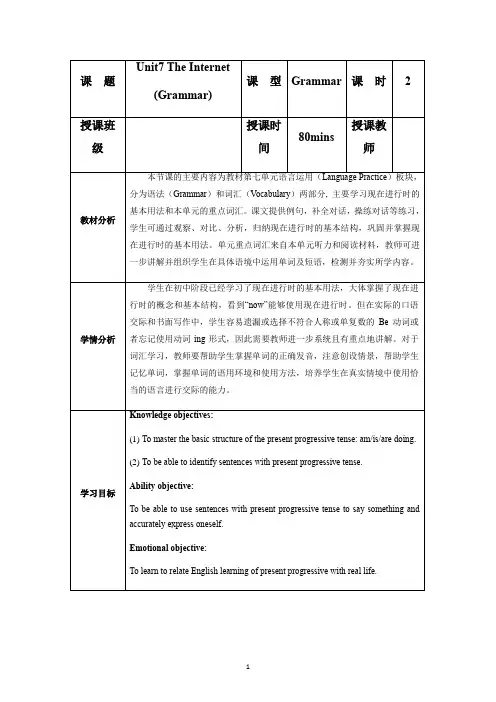
课题Unit7 The Internet(Grammar)课型Grammar课时2授课班级授课时间80mins授课教师教材分析本节课的主要内容为教材第七单元语言运用(Language Practice)板块,分为语法(Grammar)和词汇(V ocabulary)两部分, 主要学习现在进行时的基本用法和本单元的重点词汇。
课文提供例句,补全对话,操练对话等练习,学生可通过观察、对比、分析,归纳现在进行时的基本结构,巩固并掌握现在进行时的基本用法。
单元重点词汇来自本单元听力和阅读材料,教师可进一步讲解并组织学生在具体语境中运用单词及短语,检测并夯实所学内容。
学情分析学生在初中阶段已经学习了现在进行时的基本用法,大体掌握了现在进行时的概念和基本结构,看到“now”能够使用现在进行时。
但在实际的口语交际和书面写作中,学生容易遗漏或选择不符合人称或单复数的Be动词或者忘记使用动词ing形式,因此需要教师进一步系统且有重点地讲解。
对于词汇学习,教师要帮助学生掌握单词的正确发音,注意创设情景,帮助学生记忆单词,掌握单词的语用环境和使用方法,培养学生在真实情境中使用恰当的语言进行交际的能力。
学习目标Knowledge objectives:(1)To master the basic structure of the present progressive tense: am/is/are doing.(2)To be able to identify sentences with present progressive tense.Ability objective:To be able to use sentences with present progressive tense to say something and accurately express oneself.Emotional objective:To learn to relate English learning of present progressive with real life.学习重难点(1)To master the basic structure of the present progressive tense: am/is/are doing.(2)To be able to use sentences with present progressive tense to say something and accurately express oneself教学方法小组讨论法、任务教学法、情境教学法课前准备ppt课件,语音素材,视频与图片教学媒体PPT课件、多媒体设备、语音素材、拓展资源包等教学过程教学环节教师活动设计学生活动设计设计意图Step 1: Lead in Present a picture of eating the hamburger and askstudents:T: What is he doing?S: He is eating.Look at the pictureand answer thequestion: He iseating.通过图片的形式,自然引出现在完成时。
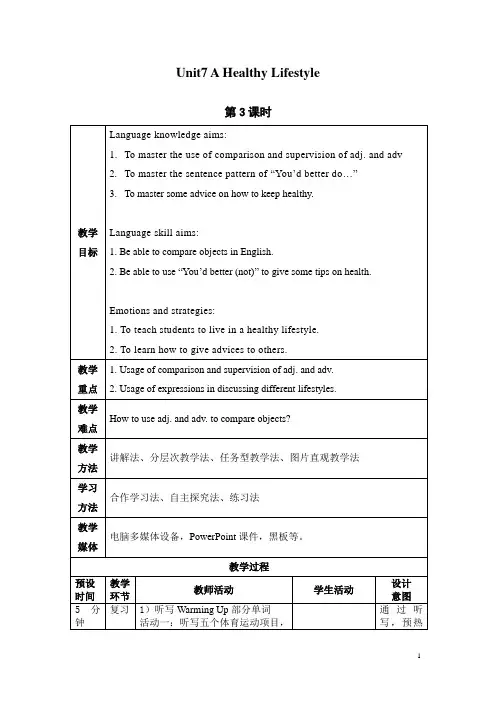
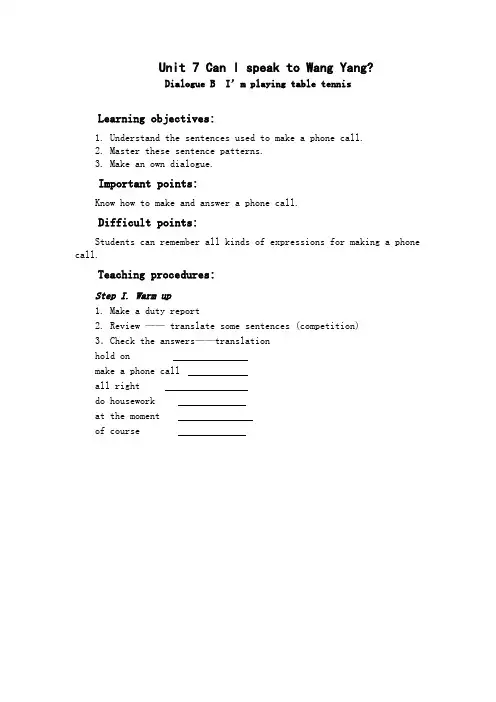
Unit 7 Can I speak to Wang Yang?Dialogue B I’m playing table tennisLearning objectives:1. Understand the sentences used to make a phone call.2. Master these sentence patterns.3. Make an own dialogue.Important points:Know how to make and answer a phone call.Difficult points:Students can remember all kinds of expressions for making a phone call.Teaching procedures:Step I. Warm up1. Make a duty report2. Review —— translate some sentences (competition)3.Check the answers——translationhold onmake a phone callall rightdo houseworkat the momentof courseStep II. Lead-inLook at some pictures,then describe them. Ask students “What are they doing?”Sara and Tang Hua are making a phone call in the last picture. What are they talking about? Please go into dialogue B.Step Ⅲ. Speaking1. Ask students to read the dialogue and answer the following questions:Q1: How many people are there in the dialogue?Three.Q2:What does Tang Hua want Sara to do ?Tang Hua wants Sara to play badminton with him.Q3:What is Sara doing?She is washing her clothes.2. Ask students to read the dialogue carefully and find out the sentences used to make a phone call.3. Translate the dialogue.4. Ask students to find out the key points and explain them.(1) May / Can I speak to Sara? Sara 在吗?(2) hold on 稍等(3) What’s up? 怎么了?与“What’s the matter? ”“What’s the problem?”意思相近(4) This is Tang Hua. 我是唐华。
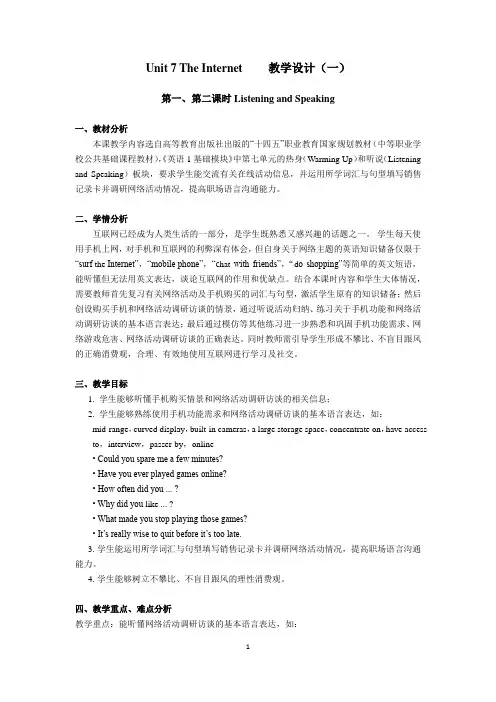
Unit 7 The Internet教学设计(一)第一、第二课时Listening and Speaking一、教材分析本课教学内容选自高等教育出版社出版的“十四五”职业教育国家规划教材(中等职业学校公共基础课程教材),《英语1基础模块》中第七单元的热身(Warming Up)和听说(Listening and Speaking)板块,要求学生能交流有关在线活动信息,并运用所学词汇与句型填写销售记录卡并调研网络活动情况,提高职场语言沟通能力。
二、学情分析互联网已经成为人类生活的一部分,是学生既熟悉又感兴趣的话题之一。
学生每天使用手机上网,对手机和互联网的利弊深有体会,但自身关于网络主题的英语知识储备仅限于“surf the Internet”,“mobile phone”,“c hat with friends”,“d o shopping”等简单的英文短语,能听懂但无法用英文表达,谈论互联网的作用和优缺点。
结合本课时内容和学生大体情况,需要教师首先复习有关网络活动及手机购买的词汇与句型,激活学生原有的知识储备;然后创设购买手机和网络活动调研访谈的情景,通过听说活动归纳、练习关于手机功能和网络活动调研访谈的基本语言表达;最后通过模仿等其他练习进一步熟悉和巩固手机功能需求、网络游戏危害、网络活动调研访谈的正确表达。
同时教师需引导学生形成不攀比、不盲目跟风的正确消费观,合理、有效地使用互联网进行学习及社交。
三、教学目标1. 学生能够听懂手机购买情景和网络活动调研访谈的相关信息;2. 学生能够熟练使用手机功能需求和网络活动调研访谈的基本语言表达,如:mid-range,curved display,built-in cameras,a large storage space,concentrate on,have access to,interview,passer-by,online• Could you spare me a few minutes?• Have you ever played games online?• How often did you ... ?• Why did you like ... ?• What made you stop playing those games?• It’s really wise to quit before it’s too late.3.学生能运用所学词汇与句型填写销售记录卡并调研网络活动情况,提高职场语言沟通能力。
中职英语模块Unit全单元教案一、单元概述单元主题:日常生活单元目标:通过学习本单元,学生能够掌握日常生活中常用的词汇和表达方式,提高日常英语交流能力。
二、教学内容1. 词汇:教室、同学、老师、学校、图书馆、餐厅、体育课、英语课等。
2. 语法:一般现在时态、一般过去时态、一般将来时态。
3. 功能句型:问候与介绍、询问与回答、描述与交流。
三、教学重点与难点1. 重点:词汇、语法、功能句型的学习和应用。
2. 难点:一般过去时态的运用、复杂句型的构建。
四、教学方法1. 任务型教学法:通过设定各种日常生活中的情境,让学生在完成任务的过程中学习和应用英语。
2. 交际法:引导学生进行角色扮演、小组讨论等互动活动,提高他们的口语表达能力。
3. 情境教学法:通过模拟真实的生活场景,让学生在实际环境中学习和使用英语。
五、教学步骤1. 导入:利用图片或实物展示本单元主题,引导学生谈论日常生活。
2. 学习词汇:教授本单元所需掌握的词汇,让学生通过卡片游戏、词汇接龙等形式进行巩固。
3. 语法讲解:讲解一般现在时态、一般过去时态、一般将来时态的用法,并通过例句进行说明。
4. 功能句型练习:让学生进行角色扮演、小组讨论等活动,运用所学词汇和语法进行交流。
5. 课堂作业:布置相关的写作、翻译等作业,让学生课后巩固所学知识。
6. 总结与反馈:在课程结束时,对学生的学习情况进行总结和反馈,鼓励他们继续努力。
六、教学评价1. 评价方式:过程性评价与终结性评价相结合。
2. 评价内容:词汇掌握、语法运用、功能句型使用、口语表达、作业完成情况等。
3. 评价方法:课堂观察、学生互评、教师评价、作业批改等。
七、教学拓展1. 课外阅读:推荐学生阅读与日常生活相关的英语文章,提高他们的阅读能力。
2. 课外活动:组织英语角活动,让学生在实际环境中练习英语口语。
3. 网络资源:利用网络资源,为学生提供更多的学习资料和交流平台。
八、教学建议1. 针对不同学生的学习程度,适当调整教学难度和节奏。
Unit 7Can I speak to Wang Yang授课内容:Unit 7: Lead in; Listening and Speaking; Reading and Writing; Languagein use语言知识目标:学生能够理解并运用正确的打电话用语,并正确使用现在进行时态表达正在进行的动作,认识部分与体育有关的词汇。
语言技术目标:听——学生能够听懂打电话用语。
说——学生能够使用正确的方式打电话。
读——学生能够读懂介绍正在进行的动作或行为的与体育有关的文章。
写——学生能够运用正在进行时态写出正确的句子。
学习策略:学生能够将动词词组与名词词组进行正确的搭配。
文化意识:学生能够认识英语中打电话的习习用语与汉语的打电话用语的差异。
感神态度:学生能够认识和正确运用英语与他人通电话。
单元任务:学生就最喜欢的体育明星作报告。
Lesson One授课内容: Lead in; Listen and Speaking Dialogue A授课目标:1 知识目标: words and expressions; Making and answering a phone call2能力目标: Understand talks about sports.Describe actions授课要点: Understandane-mailonsportsgames;Writeareportonafamousplayer授课难点: Four-skill words and expressions授课方法:启示式,互动式授课工具:教科书,收音机德育要点:学生能够认识和正确运用英语与他人通电话。
授课步骤:Step One:Presentation教师活动: Look and match.看图,将以下北京奥运会的运动项目图标与项目名称搭配。
volleyballbaseballbadmintonfootballswimmingtabletennisbasketballStep 2Lead in学生活动: Read and tick.选出每组中更适合用于打电话的语句。
Unit 7Can I speak to Wang Yang教学内容:Unit 7: Lead in; Listening and Speaking; Reading and Writing; Language in use语言知识目标:学生能够理解并运用正确的打电话用语,并正确使用现在进行时态表达正在进行的动作,了解部分与体育相关的词汇。
语言技能目标:听——学生能够听懂打电话用语。
说——学生能够使用正确的方式打电话。
读——学生能够读懂介绍正在进行的动作或行为的与体育相关的文章。
写——学生能够运用正在进行时态写出正确的句子。
学习策略:学生能够将动词词组与名词词组进行正确的搭配。
文化意识:学生能够了解英语中打电话的习惯用语与汉语的打电话用语的区别。
情感态度:学生能够了解和正确运用英语与他人通电话。
单元任务:学生就最喜欢的体育明星作报告。
Lesson One教学内容:Lead in; Listen and Speaking Dialogue A教学目标:1知识目标:words and expressions; Making and answering a phone call2能力目标:Understand talks about sports. Describe actions教学重点:Understand an e-mail on sports games;Write a report on a famous player教学难点:Four-skill words and expressions教学方法:启发式,互动式教学工具:教科书,收音机德育要点:学生能够了解和正确运用英语与他人通电话。
教学步骤:Step One: Presentation教师活动:Look and match.看图,将下列北京奥运会的运动项目图标与项目名称搭配。
volleyball baseball badminton footballswimmingtable tennis basketballStep 2Lead in学生活动:Read and tick.选出每组中更适合用于打电话的语句。
(1)( ) A. Hello! ( ) B. How do you do(2)()A. Can I speak Ben Bush ( ) B. I want to talk to Ben Bush.(3) ( ) A. Who are you ( ) B. Who is that(4)( )A.I am Ben Bush. ( )B.This is Ben Bush speaking.(5) ( ) A. Is that Ben Bush ( ) B. Are you Ben BushStep 3 listening and speaking教师活动:Can I speak to Wang Yang学生活动: Listen and choose.听录音,选择正确答案。
They will go to __________ restaurant. A YueguangListen and tick.再听录音,选择正确的表述。
B MeiweiThe phone call is between __________.a. Tang Hua and her fatherb. Tang Hua and Wang Yangc. Tang Hua and Wang Yang’s fatherListen and tick.再听录音,勾出正确的便条。
From: Tang Hua Come to school this afternoon to play basketball.From: Tang Hua Come to school this afternoon to play football.From: Tang Hua Come to school tomorrow to play football.Read and underline.阅读对话,用下画线标出打电话和接听电话的语句。
Wang Yang’s mother: Hello!Ben: Hello! This is Ben. Can I speak to Wang YangWang Yang’s mother: This is his mother speaking. Wang Yang isn’t in at the moment.May I take a messageBen:OK,thanks.Please tell him to come to school this afternoon. I want to play basketball with him.Wang Yang’s mother: All right. I’ll tell him.Ben: Thank you. Good-bye!Wang Yang’s mother: You’re welcome. Bye!师生活动:Explain the language points:重点词汇和句型This is Ben.我是Ben。
英语中打电话用this 和that 来表示“我是⋯”和“你是⋯”。
Eg:Who’s that 你是谁Is that Wang Yang 你是王洋吗This is his mother speaking.直译为“这是他的妈妈在说话。
”在打电话时意为“我是他的妈妈。
” He isn’t in at the moment.他现在不在家。
in 在这里意为“在家”。
May I take a message 可以捎个口信吗take a message “捎口信”学生活动: Listen and repeat.跟读对话,学说选出的语句。
Step 5 Sum(小结)板书设计:Unit 7 Can I speak to Wang YangWang Yang’s mother: Hello!Ben: Hello! This is Ben. Can I speak to Wang YangWa ng Yang’s mother: This is his mother speaking. Wang Yang isn’t in at the moment.May I take a messageBen:OK,thanks.Please tell him to come to school this afternoon. I want to play basketball with him.Wang Yang’s mother: All right. I’ll tell him.Ben: Thank you. Good-bye!Wang Yang’s mother: You’re welcome. Bye!Homework:(家庭作业)Recite the dialogue A.Feedback:(教学反馈)Lesson Two教学内容:Listen and Speaking Dialogue B教学目标:1知识目标:words and expressions; Making and answering a phone call2能力目标:Understand talks about sports. Describe actions教学重点:Understand an e-mail on sports games;Write a report on a famous player教学难点:Four-skill words and expressions教学方法:启发式,互动式教学工具:教科书,收音机德育要点:学生能够了解和正确运用英语与他人通电话。
教学步骤:Step One: PresentationActivity 1:Ask students to Think and answer.思考并回答下列问题。
Question 1: I’m playing table tennis.Step 2 Listen学生活动: Look and choose.看图,选择动词的适当形式填空。
Ben __________ a phone call. A. makes B. is makingTang Hua __________ housework. A. doing B. is doingLi Xiaonian and Zhang Qing __________ badminton. A. are playingplayListen and judge.听录音,判断下列图片和表述是否正确。
( ) a. Ben is making a phone call with Sara.( ) b. Wang Yang is making a phone call with Sara.( ) c. Ben is doing housework.( ) d. Sara is doing housework.( ) e. Ben and Sara are playing table tennis.( ) f. Ben and Wang Yang are playing table tennis.B.Read and underline.阅读对话,用下画线标出打电话和接听电话的语句。
Tang Hua: Hello! This is Tang Hua. May I speak to SaraSara’s roommate: Hold on, please.A moment later.Sara: Hello! This is Sara speaking.Tang Hua: Hi, Sara. This is Tang Hua. What are you doing nowSara: I’m washing my clothes. What’s upTang Hua: I’m playing badminton with Xiaonian at school.Sara: Oh! I like playing badminton best.Tang Hua: Would you like to join usSara: Of course! I’ll come soon!Tang Hua: Good! See you!教师活动:Explain some key points:May / Can I speak to Sara Sara 在吗Hold on, please.请稍等。
hold on 表示“继续”,“不挂断”。